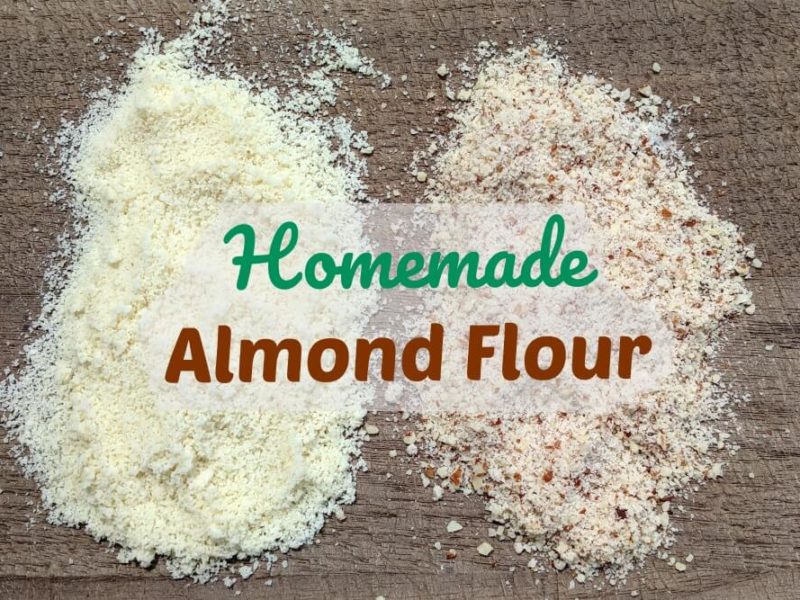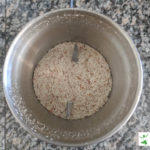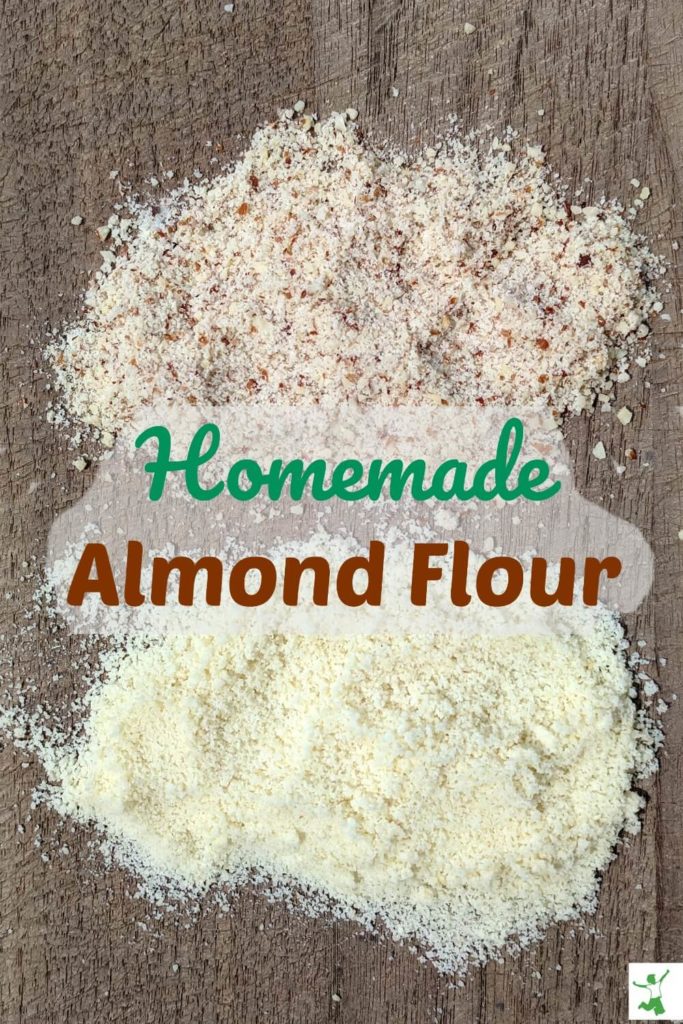How to make almond flour at home in minutes that is much more nutritious and better tasting than rancid store bought meal.

The increasing prevalence of grain allergies has many people baking with almond flour.
It is also very popular to use in keto or otherwise low carb recipes.
The downside is that buying it is not such a great idea. Let’s explore the reasons why and discuss how to make the different types of almond flour quickly and easily instead.
Issues with Store Bought Almond Flour or Meal
The fatty acids in almonds are mostly oleic (60%), which are resistant to rancidity. However, about 25% of the fat is polyunsaturated, which goes rancid quickly upon exposure to air and light.
When these delicate fats are contained within a whole almond, they are protected. Once ground they quickly go rancid especially when packed in clear plastic bags, which lets in light completely unobstructed.
Think about the length of time it takes for the following steps to occur.
- Grinding almonds into flour at the factory.
- Shipping to the company warehouse.
- Trucking to individual stores.
- Sitting on a store shelf.
- You buy it and it place it in your pantry.
This can be weeks or even months long!
There is little doubt that almond flour from the store is either partially or completely rancid by the time you use it.
Rancid flour is loaded with free radicals – you don’t want this in your body as it can exacerbate health problems!
Another issue is that almonds are quite high in anti-nutrients such as phytic acid and oxalates.
Simply grinding them up to use in baking recipes is not sufficient to neutralize these substances.
Almonds need to be soaked/dehydrated OR sprouted before grinding into flour to minimize these gut irritating substances.
Homemade Almond Flour Tips
Once you realize how easy it is to make fantastic quality almond flour, you will never go back to buying it!
Here are a couple of tips I’ve learned along the way.
First, be sure to avoid grinding almonds in a grain grinder. Nuts are too oily for most grain grinders to handle. It gunks up the mechanism and otherwise makes a mess.
Second, if you try using a food processor (unless you have a Vita-Mix), that doesn’t work so well either. Most models don’t grind the nuts finely enough to make a good baking flour.
The solution? Use a good quality electric spice and coffee grinder that easily disassembles for easy cleaning.
This is the spice/coffee grinder I use. It has two attachments. One for coarse and the other for fine grinds. It makes fantastic homemade almond flour or meal. It is also very inexpensive.
Once you have the right equipment on hand, you are ready to make your own almond flours.
Soaked or Sprouted?
Almond flour from either soaked or sprouted nuts is fine. They are both very easy to digest and extremely nutritious.
Soaking and dehydrating nuts before grinding into flour is a time consuming process. If you go with this approach, I suggest making large batches and then refrigerating. Be sure to use raw, unpasteurized almonds if possible.
If you wish to make fresh almond flour for each recipe, I would recommend using sprouted almonds (this is where I buy mine).
Sprouted almonds can be made into flour immediately with no special preparation. It is the best type of almond to use for making homemade almond flour in my opinion.
I use it most often to make almond flour pancakes or low carb pizza crust.
Blanched Almond Flour
Blanched almond flour is simply flour from nuts with the skins removed.
I don’t recommend baking with it because much of the nutrition has been stripped away.
That said, if you must use it due to sensitivity or another reason, you will have to soak raw almonds overnight and then remove the loosened skins before dehydrating.
At that point, you can grind the dried, skinless almonds into blanched flour using the same process as whole nuts below.

How to Make Almond Flour
Easy method for making the most nutritious almond flour at home in minutes that is much better tasting than rancid store bought flours and meal.
Instructions
-
Pour almonds into the food holder of your electric grain/spice grinder. Be sure to use the correct attachment for nuts.

-
Pulse until almonds are fully ground into smooth flour. Makes about 1 cup.

-
Use in baking recipes immediately and refrigerate any leftovers.
Recipe Video









I bought your recommended Raw, Unpasteurized Almonds (Terrasoul) and just to check, I tried sprouting them, using this (dontwastethecrumbs.com/sprouting-almonds-giving-food-new-life/) method. I never saw any green sprout. Have you been able to sprout them? I saw that some Amazon reviewers were reporting success, but they didn’t sprout for me.
How do we use soaked almonds to make this?
You would have to dehydrate the soaked almonds in a warm oven or a dehydrator and then grind into flour.
Anybody else get sticker shock on the price of those sprouted almonds? They cost over $30 per pound.
How might I make almond flour from the pulp I have leftover after making my almond milk? (I soak my almonds and then use the Vitamix –then a nut bag. I would love to know how else I could use this leftover almond pulp. 🙂 Thank you
You can compost it or you could dry it thoroughly in a warm oven and then grind into fine flour with your food processor.
You mentioned that blanched almonds are stripped of nutrients – is it because of the process or there are lots of nutrients in the skin? In her book “Nourishing traditions” Sally Fallon recommends using skinless almonds because they’re easier to digest.
As mentioned in the article, if there is a sensitivity or some other reason (such as digestive) where blanched almond flour is a better choice, then choose that.
Otherwise, whole almond flour made with the skins on is nutritionally a much better option. Using blanched almond flour is like choosing white flour over whole grain flour.
How many ounces of almonds translates into one cup of flour.
Also, will a “Magic Bullet” work to grind the flour?
I’ve never actually counted the number of almonds … but 7/8 cup of almonds makes about 1 cup of flour.
I’ve never tried a Magic Bullet (I don’t own one), so not sure if that would work or not to grind the almond flour fine enough.